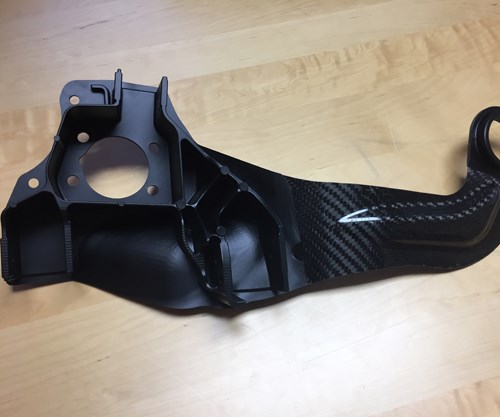Ford assesses SMC/prepreg suspension knuckle to replace metal
Ford Motor Co.'s Dunton Technical Centre in the UK has developed an SMC/compression molded carbon fiber replacement for a steel suspension knuckle. The part has production viability.

Part of the composite knuckle developed by Ford Motor Co.'s Dunton Technical Centre in Essex, UK.
Ford Motor Co. (Dunton, UK) has published a report describing a research and development effort to manufacture a carbon fiber composite rear suspension knuckle for a C-segment vehicle.
The project was undertaken by Ford’s Dunton Technical Centre (Essex, UK), Warwick Manufacturing Group (University of Warwick, UK), Gestamp (Newton Aycliffe, UK) and GRM Consulting (Leamington Spa, UK), and was designed to assess the feasibility of a composite knuckle replacing a steel predecessor.
The project, partially funded by Innovate UK and called Composite Lightweight Automobile Suspension System (CLASS), produced a composite structure comprised of carbon fiber/vinyl ester SMC with tailored reinforcement provided by a carbon fiber/epoxy prepreg. It is manufactured via compression molding with an- under 5-minute cure and weighs 50% less than the all-steel version. The composite part had to accommodate metallic fasteners, meet current hard point locations, and comply with Ford Motor Co. noise, vibration and handling (NVH) requirements.

Steel knuckle that the composite knuckle is designed to replace.
Yatish Chandra, one of the report’s authors and a composites CAE engineer, Research and Advanced Group at Ford, says the CLASS project was facilitated in part by GRM’s finite element analysis (FEA) optimization, which accelerated layup schedule development. This helped identify the need for prepreg, which was selectively applied to the knuckle to resist buckling and compressive stresses.
The production process starts with the building of a ply stack of prepreg sheets, followed by preforming and trimming. Preforms are then inserted into a mold with the SMC and the final part is then compression molded. Trimming and drilling follows to create holes to accommodate attachment points.
Yatish notes that the goal of the project was to develop a concept process with an aim to produce the knuckle in series at a rate of about 25,000 parts/year. It’s up to Ford now whether or not it will apply the composite knuckle to a production vehicle.
The authors of the report are:
- Alan Banks, supervisor, Ford Commercial Vehicle Chassis Group (Dunton)
- Emad Wahab, senior engineer, Ford Research and Advance Group (Dunton)
- Thomas Gerhards, research engineer, Ford Research and Advance Group (Aachen, Germany)
- Yatish Chandra, composites CAE engineer, Ford Research and Advance Group (Dunton).
Click “Composite-lightweight rear suspension knuckle for a high volume passenger vehicle” to download a copy of the report.
Related Content
-
Comprehensive service formulates standard, custom SMCs
CAMX 2024: As an SMC product manufacturer, Molding Products LLC provides SMC formulations and technical support for diverse markets, from R&D to post-production.
-
SMC composites progress BinC solar electric vehicles
In an interview with one of Aptera’s co-founders, CW sheds light on the inspiration behind the crowd-funded solar electric vehicle, its body in carbon (BinC) and how composite materials are playing a role in its design.
-
Composite materials, design enable challenging Corvette exterior components
General Motors and partners Premix-Hadlock and Albar cite creative engineering and a move toward pigmented sheet molding compound (SMC) to produce cosmetic components that met strict thermal requirements.
















